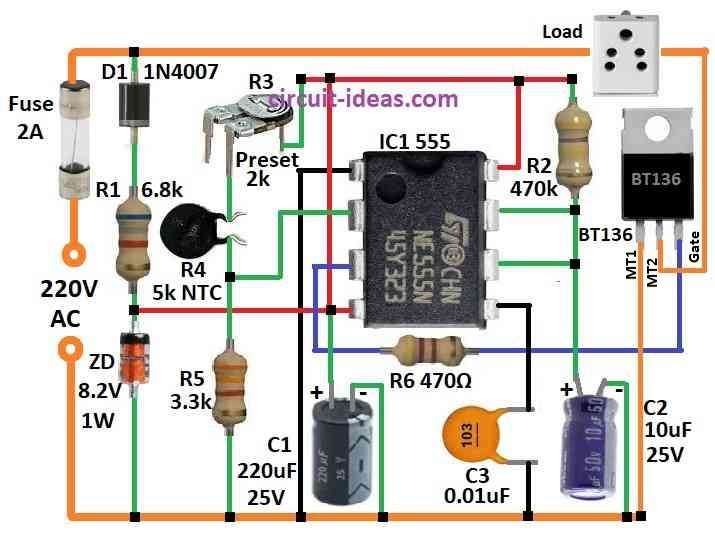This post talks about 220V Temperature Controller Circuit in easy way.
Circuit can turn ON or OFF heater, cooler or other things to keep same temperature.
It uses big power like 220V.
Has sensor like thermometer to check heat or cold.
Has small brain chip or timer to decide when to turn ON or OFF heater or cooler based on sensor.
At last switch part like relay or triac sends power to heater or cooler.
Circuit Working:

Parts List:
| Type | Value | Quantity |
|---|---|---|
| Resistors | 6.8k 5W | 1 |
| 470k 1/4 watt | 1 | |
| 3.3k 1/4 watt | 1 | |
| 470Ω 1/4 watt | 1 | |
| Preset 2k | 1 | |
| NTC Thermistor 5k | 1 | |
| Capacitors | Ceramic 0.01µF | 1 |
| Electrolytic 220µF 25V | 1 | |
| Electrolytic 10µF 25V | 1 | |
| Semiconductors | IC 555 | 1 |
| Triac BT136 | 1 | |
| Zener diode 8.2V 1W | 1 | |
| Diode 1N4007 | 1 | |
| Socket for load | 1 | |
| Fuse 2A | 1 |
We can make heat control circuit with 555 timer IC, one thermistor and some resistors.
Good thing is circuit does not need perfect power supply.
Resistors are R3 adjustable and thermistor R4 and R5.
When thermistor feels cold below set point then voltage at pin 2 of 555 goes below 1/3 Vcc.
This turns heater ON with triac and starts timer.
If temperature goes hot before timer ends then heater turns OFF when timer ends.
If not hot then heater stays ON.
Different thermistors can be used but must match temperature values.
WARNING: This circuit works with 220V main power.
Electric shock are dangerous so only experts should handle!
Formulas:
This circuit is easy type temperature controller it uses triac and 555 IC to control 220V AC power.
It turns load ON or OFF based on temperature and the temperature is checked by NTC thermistor R4.
By changing ON and OFF time it tries to keep same temperature.
Thermistors are important part and they too feel hot or cold as their resistance change with temperature so circuit can know what to do.
There is one rule to follow the formula:
R3 + R4 = 2 × R5
where:
- R3 is preset we can turn it to set what temperature we want.
- R4 is 5k NTC thermistor and it feel temperature.
- R5 give stable voltage to compare.
How to Build:
To build a 220V Temperature Controller Circuit we need to follow the below mentioned steps:
- Use good 220V AC to 12V DC power supply for this circuit.
- Be sure safety and isolation is okay.
- Put all parts on PCB like in circuit diagram.
- Connect power supply with correct + and – wires.
- Use terminal blocks to connect heater and thermistor easy.
- Change R3, R4 and R5 to set temperature we want.
- Be sure triac has heat sink to stay cool.
- Test carefully and see the heater should turn ON/OFF when temperature change.
- Use good cover and wires to stop electric shock.
- Check circuit time to time for good working and safety.
Note:
- Warning working with 220V AC is very dangerous.
- If anyone do not know how to work with high voltage then ask help from expert person.
Conclusion:
A 220V Temperature Controller Circuit is useful and works good for many things.
It uses parts like thermistor, 555 IC and relay or triac to check and control temperature.
This circuit can keep temperature at right level by turning heater or cooler ON and OFF.
We can use it in big machines like in industries or home things like for oven or AC where exact temperature is needed.
It is safe and works well and helps save power too.
Leave a Reply